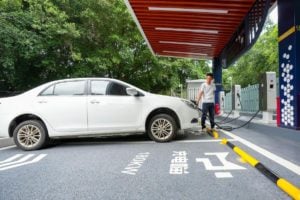A climate deal between China and the US, the world’s two largest emitters of global-heating greenhouse gases, is a bright spot ahead of tough negotiations at the COP28 climate talks starting in Dubai on 30 November.
US and China climate watchers say the agreement, which follows months of discussions and a diplomatic push to ease tensions, can inject momentum into the negotiations but still leaves much hard work for countries to agree on a successful COP28 outcome.
Under the deal, the two nations reaffirmed a commitment to work together to address the climate crisis, and to scale up renewable energy this decade to displace fossil fuels.
They committed to policy dialogue and technical exchanges on a range of issues, agreed to cooperate on advancing five large carbon capture and storage projects each, and pledged to include methane reduction targets in the 2035 climate plans they are due to release in 2025.
A symbolic location
The accord was struck by the nations’ climate envoys John Kerry and Xie Zhenhua at a meeting in the Sunnylands resort of California, a symbolic site of US–China cooperation. In 2013, Chinese President Xi Jinping and former US President Barack Obama met here for talks that paved the way to a joint pledge to reduce emissions and led to the adoption of the Paris climate agreement in 2015.
Alan Yu, senior vice president at the Center for American Progress and a former senior advisor to envoy Kerry on the Indo-Pacific region, said the deal puts “some wind in the sails for global climate action” in Dubai.
It was publicly released a day before a highly anticipated meeting between President Xi and his US counterpart Joe Biden on the sidelines of the Asia-Pacific Economic Cooperation leader’s summit in California last week.
Nearly a year to the day since Biden and Xi met in Bali, Indonesia, the meeting resumed efforts to prevent a further deterioration of relations despite fundamental disagreements on issues of trade and geopolitics.
Those efforts had come to a screeching halt after former US speaker of the House of Representatives Nancy Pelosi visited Taiwan in 2022 and Washington accused Beijing of flying a spy balloon over the US in February.
The joint climate statement demonstrates that both sides see cutting emissions as “critical enough that climate action should rise above the other challenges in the relationship,” said Yu.
A significant statement
Biden and Xi both “welcomed” the deal, according to a readout from the White House, and “underscored the importance of working together to accelerate efforts to tackle the climate crisis in this critical decade”.
“This is not as big as the agreement before Paris … but I think it’s a significant statement,” said Alden Meyer, a veteran climate watcher and senior associate at think-tank E3G. “It really does signal that both countries want a robust” political decision at COP28, which is due to set expectations for climate action in the next decade.
Specifically, the agreement will help stabilise politics at the talks, Li Shuo, director of China Climate Hub at the Asia Society Policy Institute, told China Dialogue.
But neither side made ground-breaking domestic pledges and a heavy lift is still needed for countries to agree on how to step up action at COP28. Notably, the statement makes no mention of phasing out unabated coal or overall fossil fuel use – one of the most contentious discussions points in Dubai.
On the political front, the deal will make it “harder for others to cite challenging geopolitics as a reason that delays progress”, said Bernice Lee, a distinguished fellow for sustainability at think-tank Chatham House.
Byford Tsang, a senior policy advisor at E3G, added that the common ground found between Beijing and Washington in California could even “take a bit of heat out of the COP28 discussions”.
What was agreed?
The US and China confirmed they would set economy-wide emission-reduction targets in their 2035 climate plans and include all greenhouse gases, including, importantly, methane – setting an expectation which could form the basis for agreement in Dubai. Despite being the world’s largest methane emitter, China’s current plan only covers carbon dioxide emissions.
In addition, the pair backed efforts to triple renewable energy capacity globally by 2030 – a key ask from the COP28 presidency. On achieving this goal, Zou Ji, CEO of Energy Foundation China, told China Dialogue: “China’s production capacity for renewable power equipment can help provide cost-effective solutions.”
China towers over the rest of the world when it comes to the deployment of renewable energy. In 2023 alone, the country is expected to add twice the total solar capacity of the US. Analysis shows this record growth in the installation of clean energy sources could see China’s emissions peak in 2023 – seven years ahead of its 2030 target.
Both sides agreed “to sufficiently accelerate renewable energy deployment in their respective economies” this decade “so as to accelerate the substitution for coal, oil and gas generation”.
As a result, they anticipate “post-peaking” absolute emission reductions in the power sector in the 2020s. This could signal confidence that Beijing will achieve its 2030 peaking target early and sees emissions from coal power falling in the next few years – a trajectory which is consequential for the world’s climate future.
Implications for COP28 fossil fuel ‘phase out’ debate
While the term “substitution” falls short of some countries’ push for an agreed “phase out” of fossil fuels at COP28, Li said the wording creates “an opening” for negotiations and emphasises that clean energy must be phased in before coal, oil and gas can decline.
Leading scientists and the International Energy Agency have warned that investment in new coal, oil, and gas production is incompatible with limiting global warming to 1.5C. At COP28, countries should agree to an “orderly decline of fossil fuel use, including that no new unabated coal plants are to be built,” IEA executive director Fatih Birol said recently.
But Beijing is reluctant to commit to cut fossil fuel use as it tries to bolster energy security and battle an economic slowdown.
In September, China’s climate envoy Xie said phasing out unabated fossil fuels was “unrealistic” while technologies like energy storage remain immature.
China’s huge solar and wind buildout hasn’t yet translated into a reduction in coal capacity. In fact, since President Xi pledged in April 2021 to “strictly control coal-fired power generation projects”, China’s coal pipeline has skyrocketed.
“The litmus test of whether China is serious about raising its ambition on climate action is to see if it would support strong political commitments at COP28… on phasing down fossil fuel, including coal,” said Tsang.
The US, the world’s largest producer of oil and gas, has previously said it supports a phase out of unabated fossil fuels. At the same time, it accounts for more than a third of planned global oil and gas expansion to 2050 – the largest share of any country.
Key areas for cooperation
Outside UN climate negotiations, the US and China have identified key areas for cooperation. Methane emission reductions is one of them.
Earlier this month, two years after Beijing and Washington had jointly agreed to tackle methane emissions, China released its methane control plan. But it did so without setting numerical targets, citing “weak” baseline data. For Li, the US’s experience on the issue could help China strengthen its monitoring capacity and set targets.
Energy efficiency, developing circular economies, and efforts to halt deforestation have also been identified as areas of collaboration.
Such teamwork will not also be straightforward, however. “Wherever you have an intellectual property issue … it gets much more fraught,” said Ilaria Mazzocco, of the Center for Strategic and International Studies, noting the competitive tensions over the development of clean energy technologies.
Ultimately, US–China relations will need stability to gradually improve bilateral relations and rebuild trust, Liu Yuanling, an assistant professor at the Institute of America Studies at the Chinese Academy of Social Sciences, told China Dialogue.
But elections in Taiwan and the US next year risk injecting uncertainty into relations and could thwart fragile gains.
Liu said the US needed to demonstrate “stable” commitment to climate cooperation as “many people [in China] are worrying about the climate attitude of the next US president”.
Former President Donald Trump, who is hawkish on China and temporarily withdrew the US from the Paris Agreement, is favourite to stand as the Republican nominee, according to polls.
Sub-national teamwork
Regardless of the next White House resident, climate cooperation at the sub-national level offers a reliable way forward, argues Fan Dai, director of the California-China Climate Institute.
California has a strong track record of collaborating with Chinese provinces, cities, and research institutions on climate action and these ties recently got stronger.
In a highly successful climate-themed trip to China last month, California Governor Gavin Newsom signed five agreements to strengthen collaboration with Chinese actors, including learning from Jiangsu province about how it rapidly scaled up its offshore wind capacity.
Dai, who accompanied Newsom on the “icebreaking” trip, said the governor’s meeting with President Xi provided “the highest level endorsement for sub-national climate cooperation”.
Beijing and Washington’s intention to host a high-level event on subnational climate action in the first half of 2024 could provide the grounds to expand such cooperation.
For Dai, this sub-national dialogue is an “important starting point for a new era of US–China relations”.








